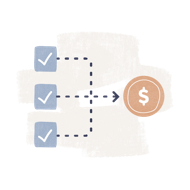If you’ve applied for a small business loan before, you’re reasonably familiar with how a lender decides whether or not they want to work with you. Many will want to look at your credit scores (personal and business), business tax returns, monthly bank statements, and more. They’ll want to know how much money you business is bringing in, how much money is going out, and where it’s going.
Most lenders will also want to know what existing debt you and your business have. They’ll calculate what’s called a debt-service coverage ratio (DSCR), which is a measure of your company’s free cash flow available to meet current debt obligations.
How is Debt-Service Coverage Ratio calculated and what does the value mean?
Debt-service coverage ratio is typically calculated using this formula:
DSCR = net operating income / debt service
Where net operating income (NOI) is net income plus taxes and interest payments. Net income in the number that will appear on your P&L statement; it is the revenue you brought in for the year minus the expenses you incurred.
Debt service is your business’s total amount of debt owed across the same period. More specifically, it is the amount of debt payments (principal + interest) you’ve paid throughout the year or will pay in the year (your current and proposed debt payments). A lender will likely include any existing debts in addition to the cost of any future loan you take on.
Here’s a small example. If you have $10,000 current and anticipated debt for 2018, but a forecasted net operating income of $15,000, your DSCR will be:
$15,000 / $10,000 = 1.5 DSCR.
In this example, the business has more planned NOI coming in than total debt. If you calculate your DSCR = 1, this means that you have just enough operating income coming in to meet your debt obligations, and a DSCR < 1 means your business lacks the operating income to cover debt obligations.
Global DSCR
If a lender wants to get a full picture of the relationship between your personal and business income and debts, they may calculate what’s called a “global DSCR.” The global DSCR takes into account all available free cash flow and debt payments from the borrower and all guarantors, as well as the business. It can be calculated using the following formula:
Global DSCR = (net operating income + personal income) / (business debt service + personal debt service)
For some loans, personal income and personal debt service goes beyond just the proprietor and guarantors to include any related parties that may drain the cash reserves of the proprietor and the business.
What is a good DSCR?
Lenders generally want to see a DSCR of 1.25 or higher—meaning if you have a $1,000 in debt obligation, you’ll need $1,250 in net operating income to qualify for a loan.
A DSCR of less than one is a red flag for small business lenders. Where there are cases where a DSCR of less than one makes sense, these cases are few and far between, and a small business lender will generally rule out a business with calculated DSCR < 1.
Why do I need to know what my business’s Debt-Service Coverage Ratio is?
DSCR can’t paint a full picture of a business’s income and debt, but it is an important risk signal for lenders. Your DSCR tells lenders how likely you are to need to dip into cash reserves, or even default on your loan because of low operating income mixed with high debt. A company’s DSCR can determine whether or not the company is approved for financing, how much financing, and the rate and terms they are offered.
If you are denied a small business loan, small business lenders aren’t required by law to give you additional information about why your loan application was denied. This is different from personal loans, for which lenders are required to give more information. Calculating your DSCR before you apply for a business loan and knowing a lender’s requirements can save you time and money.
Related loan articles
7 Options for Small Business Startup Loans
How to Get a $50k Startup Loan with Reasonable Interest Rates
This article was originally written on June 7, 2018 and updated on November 12, 2018.


Have at it! We'd love to hear from you and encourage a lively discussion among our users. Please help us keep our site clean and protect yourself. Refrain from posting overtly promotional content, and avoid disclosing personal information such as bank account or phone numbers.
Reviews Disclosure: The responses below are not provided or commissioned by the credit card, financing and service companies that appear on this site. Responses have not been reviewed, approved or otherwise endorsed by the credit card, financing and service companies and it is not their responsibility to ensure all posts and/or questions are answered.